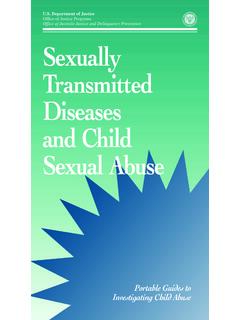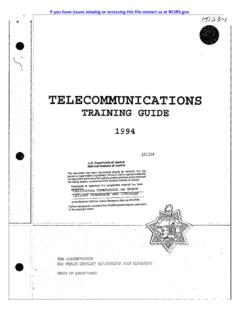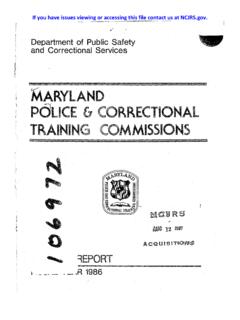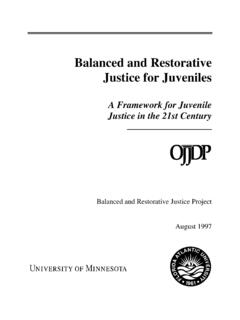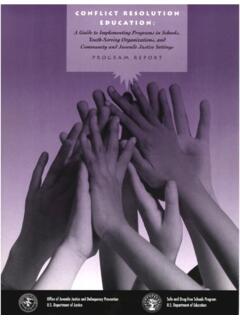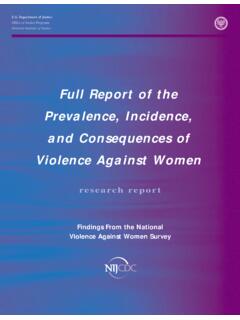Transcription of Crime & Victimization in the United States
1 Crime & Victimization in the United States2017 National Crime Victims Rights Week: Crime and Victimization Fact SheetsThe FBI s Uniform Crime Reporting Program (UCR) and the Bureau of Justice Statistics s National Crime Victimization Survey (NCVS) are the two largest and most comprehensive resources for information relating to Crime and Victimization in the United States . While the UCR and the NCVS serve separate purposes, they complement each other in a number of ways. The most important distinction between the two is that the UCR reports information regarding crimes known to law enforcement agencies (but cannot reflect unreported Crime ), while the NCVS measures reported and unreported victimizations, helping researchers identify the dark figure of Crime those hidden victimizations that the UCR is unable to track.
2 Together the UCR and the NCVS provide researchers, policymakers, and the public with a general understanding regarding the state of Crime and Victimization in the United States . Uniform Crime Report The Uniform Crime Report (UCR), launched in 1929, collects information reported to law enforcement agencies on the following crimes: murder and non-negligent homicide, rape, robbery, aggravated assault, human trafficking, burglary, larceny-theft, motor vehicle theft, and enforcement agencies also report arrest data for 22 additional Crime categories ( , forgery and counterfeiting, drug abuse violations, disorderly conduct, vagrancy).
3 Each year, the FBI issues a report on the main UCR findings, titled Crime in the United States , as well as several other reports ( , Hate Crimes 2015 and Law Enforcement Officers Killed and Assaulted, 2015). The UCR presents Crime counts for the entire nation, as well as for regions, States , counties, cities, towns, tribal law enforcement, and colleges and universities. Its primary purpose is to provide reliable criminal justice statistics for law enforcement administration and Crime Victimization Survey The methodology for the National Crime Victimization Survey (NCVS), which began in 1973, differs from that of the UCR.
4 The NCVS is based on a nationally representative sample of households. Household members age 12 and older are interviewed by the Census Bureau every 6 months for a 3-year period. The NCVS collects information on the frequency and nature of: rape, sexual assault, robbery, aggravated and simple assault, household burglary, theft, and motor vehicle does not, however, measure homicide, commercial crimes, crimes against residents under 12 years old, or crimes against individuals in other residential settings ( , nursing homes, long-term care facilities), and may exclude highly mobile populations and people who are homeless.
5 It gathers information on crimes both reported and not reported to the police, estimates the proportion of crimes reported to law enforcement, and describes the reasons victims gave for reporting or not reporting. The NCVS also includes questions about victims experiences with the criminal justice system, possible substance use by offenders, and how victims sought to protect themselves. The NCVS collects demographic information about both victims and offenders ( , age, sex, race, Hispanic origin, marital status, income, educational level, relationship between victim and offender), as well as information about the crimes (including time and place of occurrence, use of weapons, nature of injury, and economic impact).
6 The NCVS also collects periodic supplements on specific Crime issues such as stalking or school Crimes murder/non-negligent manslaughter rape robbery aggravated assault human trafficking burglary larceny-theft motor vehicle theft arson NCVS Crimes rape sexual assault robbery aggravated assault simple assault household burglary theft motor vehicle theft RESOURCESFBI, Uniform Crime Reporting, ( Department of Justice), of Justice Statistics, National Crime Victimization Survey, ( Department of Justice), Improvements1. Continuing the transition from SRS (the current UCR method of data collection) to the National Incident Based Reporting System (NIBRS) by 2021.
7 2. Providing researchers, policymakers, and the general public with information regarding the use-of-force or the discharge of a firearm by law enforcement officers. NCVS Improvements1. Providing subnational estimates: While the original purpose of the NCVS was to provide estimates of Victimization at the national level, the NCVS subnational program underway will generate Victimization estimates for the 22 largest States . 2. Modernizing socio-demographic information to reflect Victimization by sexual orientation, gender identity, veteran status, and citizenship. 3. Expanding the information collected about formal and informal help-seeking behavior, issues related to fear of Crime , and perceptions of neighborhood disorder and police performance.
8 4. Expanding the type of crimes collected in the NCVS, including stalking and fraud. The Bureau of Justice Statistics in partnership with the Office for Victims of Crime is also launching the new Victim Services Statistical Research Program (VSSRP) to build a critical body of knowledge for the field by collecting and analyzing national data from victims and the diverse entities that serve them. In addition to data collected from victims as described above, data collected directly from entities that serve victims is important for understanding whether providers have the capacity to meet the needs of all victims seeking services.
9 BJS s VSSRP includes a number of initiatives to collect information from victim service providers, including the new National Census of Victim Service Providers (NCVSP) and National Survey of Victim Service Providers (NSVSP), both designed to help define and enhance understanding of all types of providers in the field. While the UCR and the NCVS are important resources for researchers, policymakers, and the public, they cannot address all crimes or all victimizations. And though national collection efforts continue to grow, gaps still exist, particularly for emerging crimes, including elder Victimization , human trafficking, financial Crime (especially Internet-based fraud), stalking, and mass casualty Future of Crime and Victimization ResearchIn 2015, the UCR Program released a plan to improve and modernize their data collection.
10 Two key aspects of this plan included: The NCVS is also currently undergoing a redesign. This multi-year effort to fill long-standing gaps in information will include:Other efforts focus on particular types of service providers, such as the collaboration between BJS and the National Center for Health Statistics to develop a new National Survey of Hospital Victim Services to better understand the range of hospital services available for Crime victims. BJS has also added questions about victim services to existing surveys of law enforcement agencies and prosecutors offices. Together, all of these efforts will offer the most comprehensive picture of victim service provision to date.
